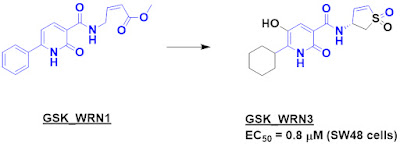Back in 2018 we highlighted diversity-oriented
target-focused synthesis, or DOTS, a combined computational and experimental
method for growing fragments. The computational piece of this has now been
turned into a free web server, called ChemoDOTS, and is described in Nucleic
Acids Research by Xavier Morelli, Philippe Roche, and colleagues at Aix-Marseille
University.
To get started, the user draws or
uploads the structure of a fragment hit they wish to expand. ChemoDOTS identifies
potentially reactive functionalities, such as amine groups. For each
functionality, the program also provides compatible reactions, derived from a
set of 58 commonly used in industry. The user then chooses one or more reactions
of interest, at which point the program generates a list of molecules that
could be created by linking the fragment to various building blocks using the selected
chemistries. The building blocks themselves consist of 501,542 commercially
available molecules from MolPort and 988,112 molecules from Enamine having
between 4 and 24 non-hydrogen atoms.
The program generates molecules
quite rapidly, between 1000-1500 per second. All of these can be downloaded
at this point, but ChemoDOTS also allows further processing. Histograms showing
molecular weight, cLogP, total polar surface area, the number of hydrogen bond
donors and acceptors, and Fsp3 for the library are displayed, and
the user can adjust sliders to select molecules having, for example, cLogP
between 1 and 3 and 0-2 hydrogen bond donors. Finally, ChemoDOTS generates three
dimensional conformers in a ready-to-dock format for each compound.
As a retrospective example, the
researchers return to the BRD4 case study we wrote about here. Starting from
the amine-containing fragment and the sulfonamidation reaction, ChemoDOTS
generated 5546 molecules in just 5 seconds, including all 17 of those
previously identified.
This is a nice approach, and I
believe the researchers are correct when they say that to the best of their knowledge
“ChemoDOTS is the only freely accessible functional and maintained web server
to combine the design of medchem-compatible virtual libraries with an integrated
graphical postprocessing analysis.” They plan to continue improving it, for example
by adding new commercial building blocks from other sources.
If I could make one suggestion,
it would be to include new types of chemistries beyond the 58, which came from a
paper published in 2011. In particular, C-H bond activation methodologies have
made impressive strides in recent years. Adding these is all the more important
given that, according to a recent analysis, about 80% of successful fragment-growing
campaigns involved growth from a carbon atom. But even in its current form,
ChemoDOTS looks to be a useful approach for growing focused chemical libraries
around fragment hits. Let us know how it works for you!



